White clothes can be a pain to wash. They always seem to turn yellow or gray, which is problematic. I have to wear white shirts for work. How do I keep them looking white? Is there an easy way to wash white clothes?
White clothes should be washed using a detergent designed to brighten whites. Keep away from chlorine bleach and fabric softener. Always check the label and wash the garment at the recommended heat setting. For an added boost of freshness, add distilled white vinegar to the final rinse. Leave white garments in sunlight to dry.
In this article, we’ll look at how to wash white clothes and keep them fresh and bright. You will learn what causes whites to discolor and how to prevent it.
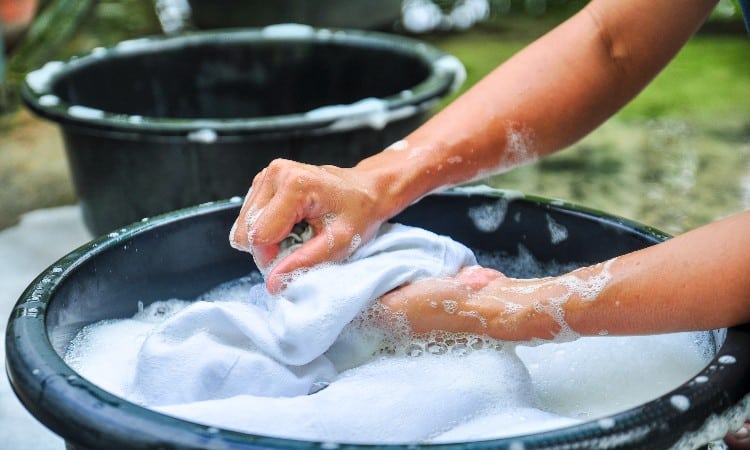
Quick Navigation
- Why Do White Clothes Turn Drab in the Wash?
- Do You Wash White Clothes in Hot or Cold Water?
- What Temperature to Wash White Clothes?
- How to Wash White Clothes
- How to Wash White Clothes By Hand
- Can You Use Chlorine Bleach to Whiten White Clothes?
- How to Whiten White Clothes Without Bleach
- What Is the Best Way to Wash Whites?
Why Do White Clothes Turn Drab in the Wash?
There are several reasons why white clothes end up being dingy and drab after you wash them. One of the main culprits is your detergent.
While detergents are all similar in that they remove dirt and grime from clothing, sometimes they can cause whites to turn gray. This could be due to using too much detergent for your wash cycle.
If you use your quick wash setting frequently, you might find it isn’t long enough to rinse all the detergent from your clothes. This can cause a build-up in the fibers of white garments, making them appear dull.
Or you could be using the wrong type of detergent. Many detergents have added bleach, which can harm white clothes.
It’s a common misconception that using chlorine bleach can brighten clothes. When the reality is that bleach can remove the color from your laundry. White clothes can be made from lots of different fibers and they are treated with brighteners to ensure they look vibrant and white.
Bleach can and will strip those brighteners out of the fabric, leaving your whites dingy and drab, especially if your best white shirt has polyester or some other synthetic content.
As artificial fibers tend to have a yellow tinge, they are dyed to make them look more attractive. Adding bleach to the wash will remove the dye leaving the original yellow shining through.
It’s not just your detergent behind the drab new look for your white clothes. A fabric softener can also suck the brightness out of your whites. To soften your clothes, fabric softeners leave behind a residue or film coating the fibers. This residual coating builds up and causes your white clothes to turn a dingy gray.
Another contributing factor to the drabness in your white laundry is how you wash them. If you’re like me, you want to get the most out of each wash. Running a machine for one or two white articles isn’t energy efficient. So you grab some stuff out of your laundry basket and shove them all in together. Blue jeans or red socks, it doesn’t matter. If it fits in the machine, it goes in.
As long as the temperature is cold, it’ll wash everything, right? Well, no, not really. It might be great for water conservation and score you brownie points on your energy bill. But, it isn’t going to do anything for your white garments. Those socks will turn your white shirt a subtle shade of pink even if the water is cold.
Which gives you another problem. Not all clothing is designed to be washed at the same temperature. Some like it hot, while others prefer a cooler dip. When it comes to white laundry, you need to double-check that care label.
Whites need to have the temperature just right. Otherwise, the dirt will stay where it is. They’ll even pick up dirt from other garments, causing them to look dirtier after washing.
Then there is the machine itself. Your eagerness to get as much laundry as possible could hinder your chances of getting a clean wash. Overfilling a washing machine is almost as bad as using too much detergent.
With too many garments inside, the washing machine will struggle to work properly. The water won’t drain out; the spin cycle won’t be able to get going. Before you know it, you have a dirty machine and your washing is soaking in grubby water. White garments will suck up all that wet griminess like a sponge.
We all expect our detergents to remove stains. However, even the best detergent will struggle with stubborn or ground-in stains. Many stains require pretreatment to loosen them up a bit, particularly if they are dried on.
Unfortunately, many of us skip the presoak, so the garments will be out of the wash quicker. This isn’t always a good idea. Some stains get worse the longer you leave them. A half-hearted effort to remove them will push them deeper into the fabric. Think about your underarms for a moment.
Have you noticed how the stains just seem to get bigger and bigger after every wash? Underarm stains are particularly problematic to budge. Whether it’s due to sweat or deodorant residue, not pretreating this type of stain can create disaster for your white shirt.
There is also the age factor. With the best washing processes in the world, there is an ugly truth regarding white garments. At some point, the age of the garment and the number of times it has been washed will make it turn gray.
Do You Wash White Clothes in Hot or Cold Water?
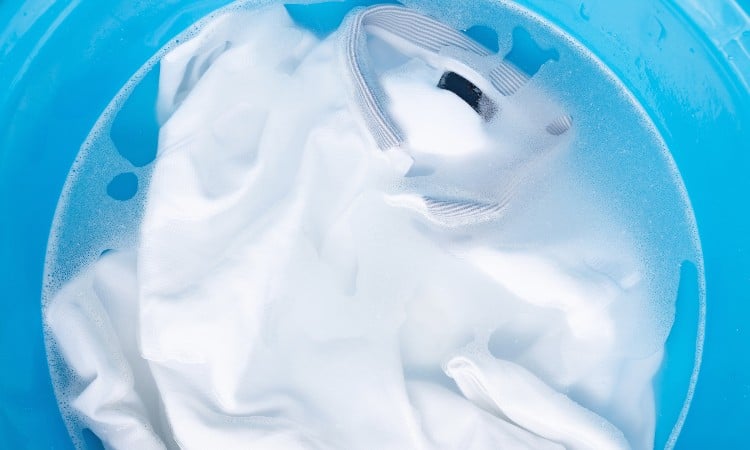
- You can wash white clothes in either hot or cold water. You’ll get better results if you wash the garment on the hottest setting it can stand. Dirt and stains lift out fibers easier if the water is warm or hot. However, some delicate garments can only withstand cool temperatures.
- The truth is, it depends on the clothes and the fiber content they contain. A synthetic fiber, for instance, will fair badly in hot water. Washing white clothing at the wrong water temperature will have a negative impact on your garment. It will remove the brightness making your clothing look drab and dull.
- One thing you should always do with white clothing is to check your garment’s care label. The manufacturer will have tested the garment to find out what washing regime works best. Be that by hand or machine.
- Their recommendation will also let you know what water temperature you should use. Following their instructions will ensure the longevity of your white garments.
What Temperature to Wash White Clothes?
The temperature you wash your white clothes at depends on the clothes. Many white garments can be delicate and need a lower setting. While things like towels and bedsheets can be washed at higher temperatures.
As mentioned in the previous section, hotter temperatures are more effective at removing grime, sweat, and food stains. But, not all fabrics can withstand heat. Some white material can turn yellow if the water temperature is too hot. It will suffer the same fate in water that is too cold.
If your white sweater is made from wool or has any synthetic content, you should avoid heat. Instead of cleaning the garment, you’re more likely to shrink it.
White clothing is particularly fussy about how you wash it. This is one reason why garment manufacturers always put care labels on the articles they make. They know it can be challenging to figure out how to wash your clothing and keep your whites looking bright.
Follow their instructions and wash your white clothing according to their recommendations. They will let you know the best water temperature for your item. If there isn’t a care label, play safe and hand wash your clothing using lukewarm water.
How to Wash White Clothes
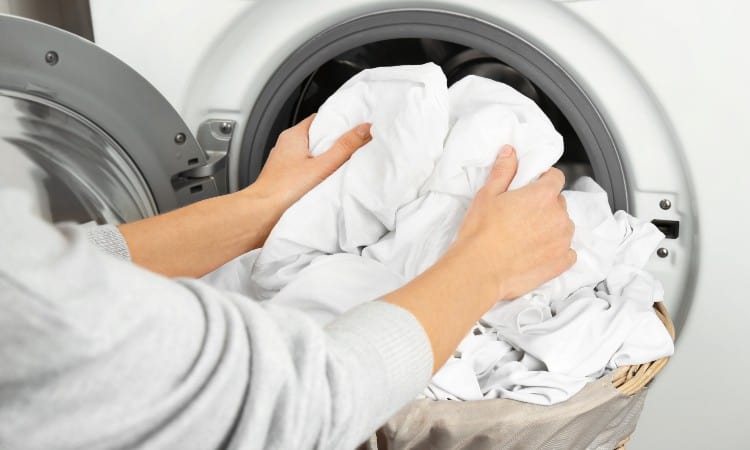
You’re probably thinking that owning white clothes is more hassle than it’s worth. With their annoying habit of turning as dull as dishwater, you might think it’s easier to start with a gray shirt. If it’s going to end up that color anyway, may as well save time.
Fear not, it doesn’t have to be that way. White clothes are easy to wash if you treat them with consideration and care. In this step-by-step guide, I’ll show you how to wash your white clothes, so they keep their brilliant sparkle for longer.
You will need:
- Washing detergent designed for white clothing
- Washing machine
- Clothesline
- Clothes pegs
- Distilled white vinegar
- Laundry brighteners like Borax
Step 1 – Clean Your Machine
Start with a clean washing machine. You’ll never get your white clothes clean if your machine still has traces of mud in it from the last time you washed your hiking gear.
Run your washing machine empty on a hot cycle every once in a while. Use the recommended dose of detergent for a heavily soiled wash. Add 1 cup of distilled white vinegar to knock any bacteria on the head.
Step 2 – Sort the Laundry
The next thing to do is sort your laundry. You want to make sure you only wash white items with other white garments. That way, you reduce the risk of color bleeds. There will also be less chance of dirt from darker clothing seeping into the wash.
As we tend to wash white clothes more frequently than any other color, the water in the washing machine is usually cleaner. Add a pair of dirty blue jeans, and that water will end up a dirty shade of brown. White clothing sucks up dirty water like a sponge and will look dismal.
Step 3 – Read the Care Label
Always read the care label. Manufacturers put care instructions inside their garments to help us figure out things like water temperature. The label will also advise on how to dry the garment. This is the reason you should never remove care labels.
These labels are their recommendations for how to wash clothing safely, regardless of its color. For white clothing, following the instructions can make the difference between a dingy gray and prolonged brightness. Adhere to the manufacturer’s directions and your white shirt will stay fresh and bright for longer.
If there isn’t a label, treat your white garment as though it is a delicate item made from silk. Skip the washing machine and hand wash it using cool or lukewarm water.
Step 4 – Pretreat the Stains
Before you get your white clothes anywhere near the washing machine, give them a quick check. You need to look for stains. It’s always best to pretreat stains before washing your clothing, even if they are colored garments. For white garments, it’s imperative.
Check for stains and identify them. Use the recommended method for removing the type of stain you have. Then, use your machine’s prewash setting to soak the garment.
Step 5 – Choose Your Detergent
You need to use a detergent that has been formulated with white clothing in mind. Avoid any detergent that has chlorine bleach included in the ingredients. Bleach and white garments are a recipe for disaster. It will make them turn yellow.
Look for a detergent that includes optical brighteners or oxygen bleach. Oxygen bleach is hydrogen peroxide based and safer for textiles, especially if they are white. The best-known version is OxyClean.
Don’t add too much detergent to the wash, though. Too much is as bad as not enough. Follow the directions on the package and use the right amount for your level of soiling. If there is too much detergent, it may not rinse out properly.
If you want to add an extra boost, add ¼ cup of Borax to your wash. This will help brighten white garments and colored items, making them pop with renewed vibrance.
Step 6 – Don’t Use Fabric Softener
It can be tempting to add fabric softener when you’re washing white clothes. Unfortunately, fabric softener can turn whites into a depressing shade of gray. Don’t use it. Fabric softeners leave a residue behind to soften the garment. It’s this residue that dulls white garments.
For brilliant whites that are soft, clean, and sparking after the wash, use distilled white vinegar in your final rinse. Vinegar will remove any remaining detergent from the wash. It’s also a natural bleaching agent and will make your whites dazzle. Make sure it’s distilled white vinegar, though. Other kinds of vinegar will cause stains.
Step 7 – Use the Right Setting
Washing machines come with a selection of settings. Most of us use the same one regardless of what we are washing. This is a bad idea if you are washing white clothes. A quick wash on a cold setting is unlikely to get the grubbiness out. But it will strip the brightness from your whites.
Choose your wash cycle carefully. You should wash your white garments in the warmest setting they can stand. Let’s be honest; most of the stains on your whites are probably body related. Sweat around the underarm of your shirt, for instance. This type of stain is easier to remove on a hotter wash.
Similarly, your wash cycle should match the level of staining on your garment. This is true even if your shirt is blue. Heavy staining needs a longer wash so pick the heavy setting on your machine.
Step 8 – Don’t Fill to Capacity
I get it. We all want to do our part to save the planet. But, overfilling the washing machine isn’t going to help you do that. Nor will it get you whites clean, fresh, or bright.
If your washing machine is too full, it won’t work properly. Detergent won’t get rinsed out of your clothes, nor will the dirt and grime. Instead, both will build up and get re-absorbed by your clothing. It’s not going to end well. Even your colored garments will come out looking worse for wear.
Avoid having to rewash your garments by not overloading your machine. A general guideline is no more than two bedsheets at a time. Or a maximum of three shirts with four pairs of underwear and four pairs of socks.
These amounts aren’t set in stone. It will depend on what you need to wash. But, what you’re aiming for is a drum that is no more than half full with clothes.
Step 9 – Dry Naturally
Although you can dry some white clothes in your dryer, you’ll get better results if you let them dry naturally. If your care label says using a dryer is OK, then follow the instructions.
You can even use a combination of the dryer and air drying. Remove your white clothes from the dryer while they are still damp and hang them on an external clothesline to finish off. Be careful where you put the pegs, though. Peg at the hemline for shirts and waistbands for skirts and pants. This stops the peg marks from showing.
Drying your white clothes outside can make a huge difference to their vibrancy. Sunlight is a natural bleaching agent. Not only will it brighten your wash, but it will also kill any remaining bacteria.
Don’t overdry white clothing! Too much time in the dryer or out in the sun will age your garments and make them turn gray sooner.
Step 10 – Accept the Inevitable
It’s annoying, but it is the nature of white clothes to deteriorate over time. The older they get, the more gray and dingy they will become. Sometimes, you have to accept the inevitable; your favorite white t-shirt will end up as a dishcloth.
The steps mentioned in this article will help you slow down the process. Simply follow the tips in this section every time you wash your white clothes. That way, you’ll increase their lifespan and keep them looking brighter for longer.
How to Wash White Clothes By Hand
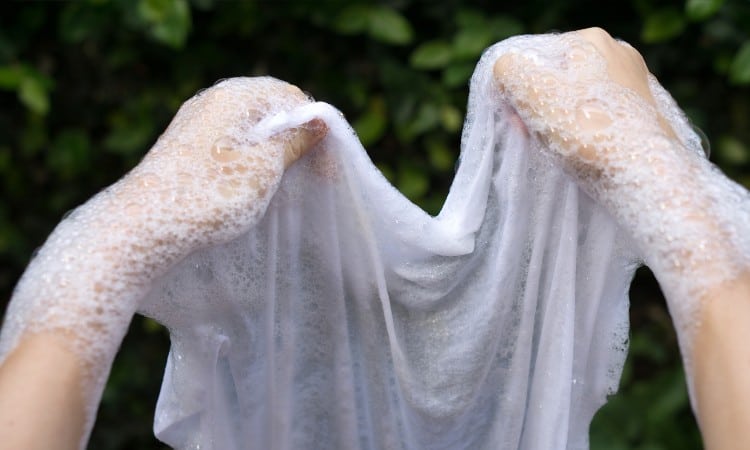
Sometimes hand washing a white garment is the manufacturer’s recommended method for cleaning. Not only because it’s gentle on the clothing, but it gives you more control over how they are washed. You can tell when the water is getting too dirty or if the detergent needs more rinsing.
You will need:
- Detergent suitable for hand washing
- Your garment’s care label
- Sink or large bowl
- Wooden spoon or laundry tongs
- Water
- Bath towel
- Rubber gloves
- Clothesline and pegs
Step 1
Fill your sink or bowl with enough water to submerge your garment. Check the garment’s care label to find out if you need hot or cold water. Wearing rubber gloves will protect your hands from the water temperature as either extreme can be uncomfortable on your skin.
Step 2
Use a detergent suitable for hand washing. Not only will this be safer for your skin, but it will also dissolve better in the water. Again, wear your rubber gloves. Even though hand washing detergent is less caustic, it can still cause skin irritation. Follow the instructions on the packaging for the correct dosage to add to the water.
Step 3
Let the detergent fully dissolve into the water. You can help by mixing it with a wooden spoon or your laundry tongs. Submerge your white garment completely. Give it a swirl. Allow the garment to soak for 10 minutes or longer if it is heavily soiled.
Step 4
Start to agitate the white clothing. Move it around, lift it and down in the water, and swirl it. Try to move it in as many different ways as you can. Just don’t twist it. Twisting some wet garments can damage the fibers. As soon as the water starts showing signs of dirt, change the water.
Step 5
Keep rinsing your garment until all traces of suds and dirt have gone. The water should run clear. Remove your clothing and gently squish the excess water out. For delicate items, wrap them in a bath towel and allow the water to soak them into the towel.
Step 6
As your garment is likely to be saturated, even after removing the excess, the best drying method is to allow it to air dry. Either roll it up in a clean, dry bath towel or hang it outside on a clothesline.
Can You Use Chlorine Bleach to Whiten White Clothes?
No, you shouldn’t use chlorine bleach to whiten white clothes. You shouldn’t use chlorine bleach on any items in your laundry. It’s bad news for fabric in general, regardless of the fiber content or color of the clothing.
Not only can it strip the color out of garments, but it is also a known culprit for turning white clothes yellow. Worse still, chlorine bleach is the public enemy number one to most synthetic materials. Your whites won’t only turn a funny shade of dismal; they may also melt.
If that wasn’t bad enough, chlorine bleach can react with some detergents. Not only can that be disastrous for your washing, but it could be potentially harmful to you too!
Bleach is one of those products that you have to be careful with. When mixed with other products, it can give off poisonous or toxic fumes. Although most detergents are fine with a bit of added bleach, you have to get the mix spot-on.
It is a lot safer to give chlorine bleach a wide berth when you are doing your laundry. There are other products you can use that are safer and less problematic to use.
Try Oxygen bleach instead. It isn’t chlorine-based and is a lot safer for your fabric and your skin. Made from hydrogen peroxide, oxygen bleach can be used on most synthetic or plant-based fabrics. You only need to keep this one away from wool, silk, and leather. Better still, you don’t have to remember any formulas for using it. Just follow the directions on the packaging.
How to Whiten White Clothes Without Bleach
There are several products you can use instead of bleach to whiten white clothing. Most of them are probably already sitting in your kitchen.
1. Distilled White Vinegar
 Distilled white vinegar is the unsung hero of the laundry room. Not only does it banish grease and other stains, but it also acts as a brightening agent. It’s slightly acidic, which means it can be used as a natural bleach.
Distilled white vinegar is the unsung hero of the laundry room. Not only does it banish grease and other stains, but it also acts as a brightening agent. It’s slightly acidic, which means it can be used as a natural bleach.
You will need:
- Distilled white vinegar
- Your usual laundry detergent
- Washing machine
Step 1
Check your white garment’s care label and set your washing machine to the correct temperature for that item. Select a cycle based on the soil level. Add the recommended dosage of laundry detergent and ½ cup of distilled white vinegar. Put your garment in the machine.
Step 2
Add ½ cup of distilled white vinegar to the fabric softener compartment. Turn the machine on and wait for the cycle to complete.
Step 3
Remove the white garment from the washing machine and allow it to air dry. Either hang outside on a clothesline or use an internal drying rack.
2. Baking Soda
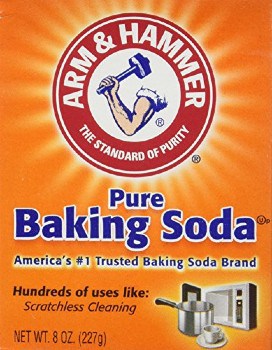 Baking soda can remove stains and rejuvenate your white clothing. It’s particularly effective at getting rid of yellowing.
Baking soda can remove stains and rejuvenate your white clothing. It’s particularly effective at getting rid of yellowing.
You will need:
- Baking soda
- Washing machine
- Your usual laundry detergent
- Large bucket
Step 1
Fill your bucket with enough water to cover your garment. Add 1 cup of baking soda and mix well. Submerge your white clothing in the bucket and leave it for an hour.
Step 2
Take your garment out of the bucket and squeeze some of the excess water out of it. Don’t twist or wring as this could damage the fibers. Wash it in your washing machine using your regular detergent.
Step 3
Once the cycle is complete, remove your garment and allow it to air dry. You can use a dryer, but ensure it is set for low heat.
3. Borax
 Borax is a natural product that brightens white clothing and eats stains. It also removes odors and can soften your water. It’s regularly used as a laundry additive to boost the effectiveness of detergent.
Borax is a natural product that brightens white clothing and eats stains. It also removes odors and can soften your water. It’s regularly used as a laundry additive to boost the effectiveness of detergent.
You will need:
- Borax
- Your usual laundry detergent
- Washing machine
Step 1
Check your garment’s care label and set your machine to a suitable temperature and wash cycle. Check your detergent packaging for the correct dosage for the soil level of your garment. Add the detergent and ½ cup of borax to the machine. Then add your garment and turn the machine on.
Step 2
Remove the garment at the end of the wash cycle. Dry in a dryer on a cool setting or hang outside on a clothesline to dry naturally.
4. Bluing Agent
A bluing agent is a product that adds a hint of blue to your wash. The added blue makes white clothes look brighter. You do have to be careful with this one. Too much bluing will make your clothes turn blue.
You will need:
- Liquid Bluing
- Your usual laundry detergent
- Washing machine
Step 1
Check the bottle of bluing for the correct dosage. Add it to the washing machine. You can do this at the start of the cycle with the detergent or as part of the final rinse.
Step 2
Wash the garment. When the cycle has finished, dry the clothing. For best results, allow to air dry on an external clothesline.
What Is the Best Way to Wash Whites?
The best way to wash whites is to follow the directions on the care label. White clothing should be washed at the recommended temperature. You should always wash whites separately and on a cycle that suits the soil level.
For an extra pop of brightness use a laundry additive like borax. Distilled white vinegar can also help boost the whiteness of your whites.
If you liked the article, let me know in the comments. How do you wash your whites? Have you used the methods listed in this article?